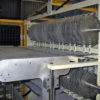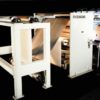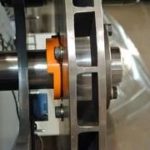In older stationary bed knife (or ‘dead knife’) cutter designs a single motor drives the pull roll section and powers a second drive train to change the speed of the revolver relative to the speed of the draw drum. Typically mechanical designs such as expansion pulleys, change gears or gear boxes were used within the second drive train to vary the sheet length. Although simple to operate and straightforward to adjust such mechanisms suffered from:
- Lengthy set up time in changing sheet size
- Excessive waste due to multiple cuts required to fine tune the cut off
- Routine maintenance to address lubrication and wear components.

- Changing the sheet length at the touch of a keypad
- No waste to confirm cut off length
- Accuracy to within +/- 1/64″ (+/- 0.38 mm) of setting
- Minimal maintenance
The routine recommended maintenance of a dual drive system includes:
- Check the drive belts for tautness on a daily basis
- Grease drive train bearings every 1000 operating hours
- Check (and replace as required) the drive enclosure air filters every three months






